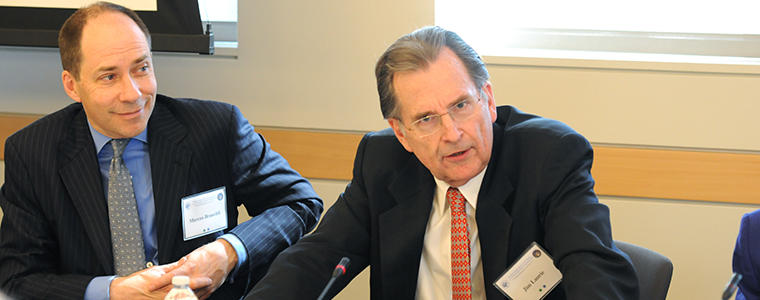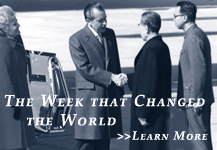The Week that Changed the World conference, co-hosted by the U.S. Institute of Peace and the Richard Nixon Foundation at USIP on March 7, drew a panel of journalistic China hands to discuss the impressions of China left by U.S. news media coverage over the past four decades.

 The Week that Changed the World conference, co-hosted by the U.S. Institute of Peace and the Richard Nixon Foundation at USIP on March 7, drew a panel of journalistic China hands to discuss the impressions of China left by U.S. news media coverage over the past four decades. Mike Chinoy, a senior fellow at the U.S.-China Institute at the University of Southern California’s Annenberg School of Communication and Journalism and formerly CNN bureau chief in Beijing, noted that producing a balanced picture of a diverse, complicated and enormous country like China has always been challenging for the media, producing “paradoxes within paradoxes of the ways people look at China.”
The Week that Changed the World conference, co-hosted by the U.S. Institute of Peace and the Richard Nixon Foundation at USIP on March 7, drew a panel of journalistic China hands to discuss the impressions of China left by U.S. news media coverage over the past four decades. Mike Chinoy, a senior fellow at the U.S.-China Institute at the University of Southern California’s Annenberg School of Communication and Journalism and formerly CNN bureau chief in Beijing, noted that producing a balanced picture of a diverse, complicated and enormous country like China has always been challenging for the media, producing “paradoxes within paradoxes of the ways people look at China.”
Jim Laurie, a veteran broadcaster and Asia specialist who was with NBC News at the time of the Nixon visit, broadly divided China coverage into two categories: First, the relatively optimistic period of reporting about China re-engaging with the international community that he dubs the “gee-whiz period,” running from 1978 to June 4, 1989, when Chinese authorities attacked student protesters occupying Tiananmen Square. Next, he said, was the “nothing good about China” period, which he said might have concluded around the time of the 2008 Beijing Olympic Games.
James Mann, author-in-residence at the Johns Hopkins School of Advanced International Studies and former Beijing bureau chief of the Los Angeles Times, argued that the “gee-whiz” tendency in media coverage “furthered U.S. strategic aims” in terms of fostering engagement with a reforming China across a range of issues.
Melinda Liu, Beijing bureau chief for Newsweek/Daily Beast, noted that the Tiananmen story sparked “the most dramatic flip-flop” in media coverage. Liu also discussed the tendency of many editors to embrace coverage that fits simple, compelling story lines, including at Tiananmen. “There was a strong tendency on the side of editors to simplify what the leaders of the protests wanted and how they were going to get it.” Remarked Chinoy, “the cuddly Communists became the ‘butchers of Beijing’.”
Marcus Brauchli, executive editor of the Washington Post and a former Wall Street Journal foreign correspondent based in Shanghai and Hong Kong, among other posts, pointed to the inherent difficulties of conveying depth on complicated subjects such as those emerging from a changing China. “Journalists can be very reductive,” he said.
Ted Koppel, a long-serving correspondent for ABC News who covered the Nixon trip, commented from the audience: “I think we’re always about ten years behind.” Nowadays, Koppel observed that relatively little is being written about Chinese perceptions about themselves, including their deep fear of chaos breaking out in the country—and how to prevent it. Liu agreed, adding, “The Chinese perceive themselves to be much weaker” than others do.
(Photo: Marcus Brauchli [left], Jim Laurie)